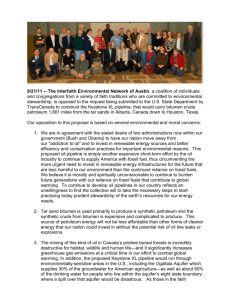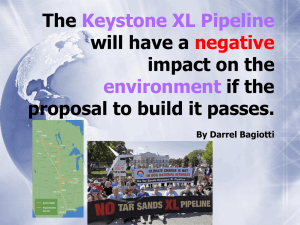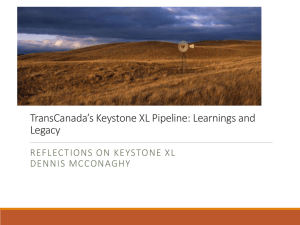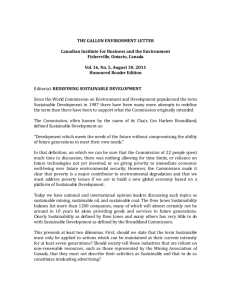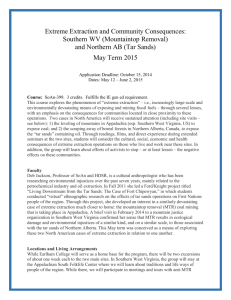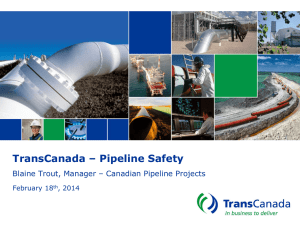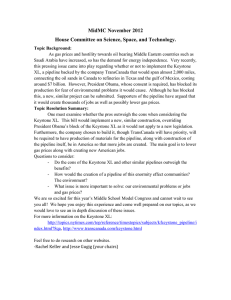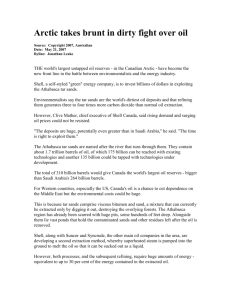A DOCUMENTARY FILM ON CANADIAN OIL SANDS DEVELOPMENT
advertisement
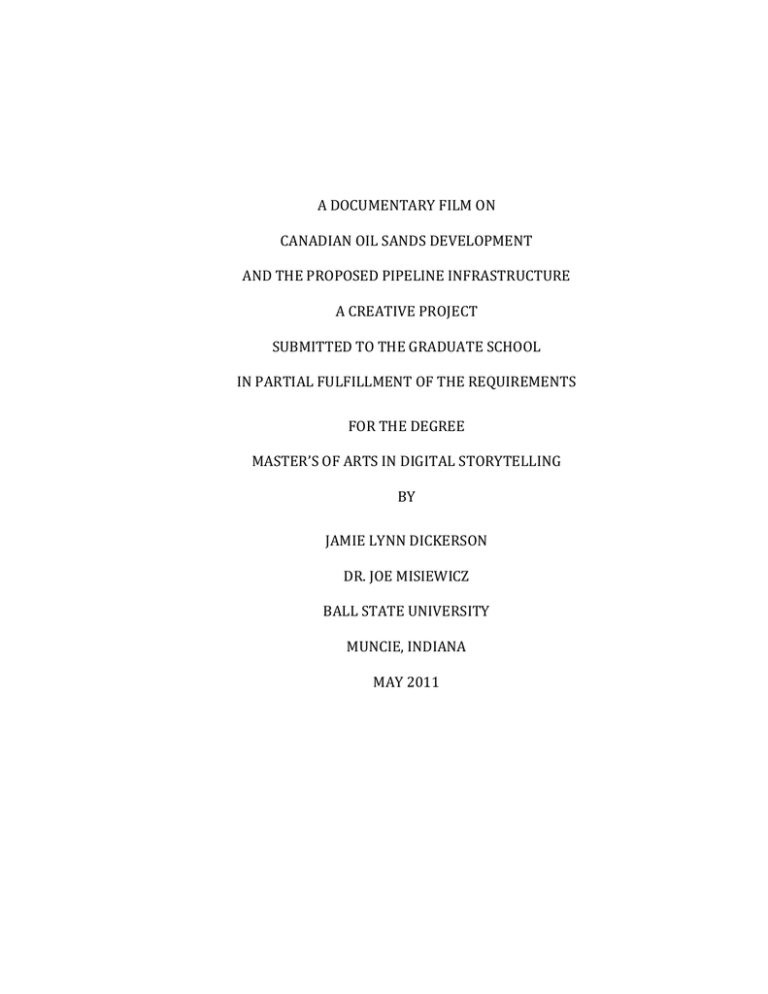
A DOCUMENTARY FILM ON CANADIAN OIL SANDS DEVELOPMENT AND THE PROPOSED PIPELINE INFRASTRUCTURE A CREATIVE PROJECT SUBMITTED TO THE GRADUATE SCHOOL IN PARTIAL FULFILLMENT OF THE REQUIREMENTS FOR THE DEGREE MASTER’S OF ARTS IN DIGITAL STORYTELLING BY JAMIE LYNN DICKERSON DR. JOE MISIEWICZ BALL STATE UNIVERSITY MUNCIE, INDIANA MAY 2011 Introduction Canadian oil sands development, also known as tar sands, in Ft. McMurray, Alberta, Canada is what environmental organizations such as the Sierra Club and Natural Resources Defense Council refer to as the most environmentally destructive project on earth. The largest engineered dykes in the world hold wastewater that contains several known pollutants that leaks billions of gallons of toxic sludge into the Athabasca River and other fresh groundwater sources every year (Nikiforuk, 2010). The environmental impact of carbon emissions, depletion of fresh water from the Athabasca River, and deforestation of the Boreal Forest, along with the polluted Athabasca River that is poisoning the fish, birds, and wildlife of Alberta, Canada are all contributing factors, which confirm that Canadian tar sands development truly is the most destructive project on earth (Cizek, 2006). The First Nations are indigenous people who reside in Ft. Chipewyan, a small island downstream, from the Suncor and Syncrude processing plants. Extremely high cancer rates have been reported among the people on the small island. The First Nations hunt beaver, muskrat, moose, and fish from the Athabasca River, as their traditional foods, and then are forced to eat the polluted animals. “They may as well be drinking from the River itself” (Cobenais, 2010). Janet Annesley, Vice President of Communications for the Canadian Association of Petroleum Producers (CAPP) said that as a lifetime Albertan her 2 knowledge of the tar sands dates back a long, long time, and has always been a very challenging resource to extract. Due to new technology and more robust oil prices tar sands extraction has become economically viable. In 2003, the U.S. Energy Information Administration recognized that “170 billion barrels of the 1.7 trillion were economically recoverable,” placing tar sands second to Saudi Arabia in the world’s oil reserves (Cizek 2006). Dick Cheney’s 2005 National Energy Policy Act approved tar sands as a source of energy for the United States. The National Energy Policy report stated that, “The continued development of the tar sands can be a pillar of sustained North American energy and economic security” (Cizek, 2006). The premise of the energy policy was to free America from foreign oil imported from unfriendly, unstable, hostile regions. Upon tar sands approval as a source of energy, TransCanada, a pipeline construction and operation company immediately drafted plans for a massive pipeline infrastructure. Keystone 1 is a 2,148-mile pipeline that traverses from Hardisty, Alberta, Canada through North Dakota, South Dakota, Nebraska, Kansas, Oklahoma, and Illinois. Since the pipelines cross international borders a U.S. presidential permit is required for construction. In March 2008, the fastest presidential permit in U.S. history was issued to construct the Keystone 1 pipeline (Thompson, 2008). The 1,980-mile proposed Keystone XL pipeline is currently under consideration with Secretary of State 3 Hillary Clinton and will traverse from Hardisty, Alberta, Canada through Montana, South Dakota, Nebraska, Oklahoma, and Texas. The Sierra Club, the Natural Resources Defense Council, and other environmental organizations are speaking loudly about tar sands development and TransCanada’s pipeline infrastructure. Because so many states are affected, how can it be that this big story escapes public scrutiny? I consider myself a considerable news consumer and learned about the story by accident. In the spring of 2008, I moved from Denver, Colorado to a very small town in South Dakota called Murdo. With a Bachelor’s degree in journalism, I worked as a cashier in a gas station. A man who was a regular customer at the store informed me one day of the many reports he had been compiling on landowners and their acreage. He proceeded to tell me about the pipeline that was proposed to traverse through the county where I was living. I was intrigued and pressed him for more information. He was a land agent for TransCanada charged with convincing local landowners to sign over a 50-foot permanent and perpetual easement to make way for the pipeline. He informed me that soon there would be a town meeting where TransCanada executives would be present to answer any questions. I immediately began researching the issue. Since I worked with the public I put the word out that I was a journalist working on the pipeline story and wanted to speak with affected landowners. One by one they began coming into the store to tell me their story and experiences with TransCanada. The more stories I heard, and the more research I 4 conducted, the more convinced I became that the newly proposed pipeline infrastructure and tar sands development, in general, was a really bad idea. Tar Sands Development Tar sands are bitumen, a sticky tar-like substance that lies beneath the Boreal Forest. “It is essentially oil that is covered in sand, water, and clay” (Annesley, 2010). The tar is extracted in two different ways. Strip mining is one method, where the overburden, which is trees, brush, and soil are removed to expose the tar, and then large trucks and shovels are used to dig it out of the ground. The tar is washed and separated from the sand. Hot water and steam is used in an agitation-like process. The sand sinks to the bottom, bitumen floats to the top and the wastewater is sent out to the tailing ponds for storage and reuse. Once oil and water interact several toxic pollutants are created. The chemical composition in the tailings ponds, which are constructed on the banks of the Athabasca River, includes naphthenic acid, mercury, benzene, arsenic, and polycyclic aromatic hydrocarbon (PAH’s) known potent atmospheric pollutants. The land mass occupied by the tailings ponds is the equivalent of 330,000 Olympic-sized swimming pools (Nikiforuk, 2010). 5 The other method is used for deposits that lie too far beneath the ground surface to dig it out. The method uses pump jacks to inject steam into the ground to melt down the tar so that it will flow through pipes up to the ground surface. Separating the tar from the sand is energy intensive. Huge amounts of natural gas, steam, and water are used. Once the tar is melted down to bitumen hydrogen is added to upgrade the substance into petroleum. Currently, production of one barrel of tar sands consumes between two to five barrels of water and enough natural gas to heat 3.2 million homes per day. Enough overburden is removed every two days to fill New York’s Yankee Stadium. The greenhouse gas emissions associated with tar sands production is almost triple that of traditional oil production (Cizek, 2006). Andrew Nikiforuk wrote in his article, “What Those Who Killed the Tar Sands Report Don’t Want You to Know,” that the Standing Committee on Environment and Sustainable Development, in Canada, abruptly cancelled its two year study on extreme water impacts from the tailing ponds and the final draft reports were destroyed by parliamentarians. He accuses the Alberta government of possessing petro-state Saudi visions of grandeur and that the report was killed because Ottawa, the capitol city in Canada, does not want the U.S. oil customers, industry investors, or Canadian taxpayers to know the truth about the environmental, and water polluting devastation occurring in Ft. McMurray, Alberta where tar sands mining occurs. Nikiforuk charged the Alberta government with insufficient oversight and of handing over regulation to the industry itself. 6 Several fish caught from the Athabasca River had huge cancer tumors and deformations. Janet Annesley from CAPP said that the fish were a hoax. A doctor had examined the fish and said they were decomposing. The industry vehemently denies that tar sands mining is responsible for polluting the River and denies responsibility for the unprecedented high cancer rates in Ft. Chipewyan. However, several pictures of deformed fish surfaced in September 2010, showing massive tumors and other disturbing deformities. Steel Controversy In April 2009, Jeff Raines, a retired steelworker in Granite City, Illinois, was waiting in his car as a train slowly passed. He noticed the flatbed cars stacked with steel pipes with “Made in India” stenciled on the side. The steel mill in Granite City had been shut down since December due to lack of orders for the first time in its 130-year history and 2,000 employees were laid-off. Raines sounded the alarm in his Illinois town, and rallied his fellow United Steelworkers Union members. Union members organized a rally in the same field where the Indian pipe was laid out. Over 1,000 protesters showed up to voice dissent over lost work due to imported steel, and the safety hazards associated with thin-walled pipe that will run at an accelerated pressure than traditional crude oil pipelines (Uchitelle, 2009). The 36-inch diameter, .38-inch wall thickness steel pipe manufactured in India is also defective. After the pipe was laid, pressure testing found that the steel 7 expanded when heated, and 47 sections on the Keystone 1 route was dug up and replaced. TransCanada purchased 560, 000 tons of steel pipe, about 47 percent of what was needed, from India’s Welspun Power and Steel, while the rest was made in America and Canada (Winchester, 2010). The United Steelworkers Union joined forces with the Sierra Club by challenging the federal permit, claiming that the thin-walled pipe, in general, is 10 percent thinner than traditional oil pipelines, and this is a safety and leak risk. The Pipeline Hazardous Materials Safety Administration (PHMSA) issued the waiver approving thinner wall steel pipe as well as TransCanada’s proposed pumping pressure variance of 1,400 to 1,800 psi (pounds per square inch) and will pump 435,000 barrels per day. Traditional natural gas and crude oil pipelines have .51inch wall thickness and run between 200 to 600 psi and are less abrasive than tar sands, but is still vulnerable to corrosion. The likelihood of rupture, leaks, and explosion is significantly greater with the highly abrasive tar sands pipeline in comparison to its wall thickness and pumping pressure. TransCanada spokesman, Jeff Raugh, stated that the steel pipe is treated with an anti-corrosion compound that will slow the corrosion process and even though the pipeline will operate under thinner walls and higher pressure it will be safer than existing traditional crude oil pipelines (Uchitelle, 2009). Eminent Domain 8 TransCanada’s Landowner Relations Supervisor, Sandra Roth sent easement letters to American landowners in which one “final” offer was proposed to acquire the private property. The letters stated that TransCanada “negotiates in good faith” and believes that the proposed amount for the land is “reasonable and adequately” compensates the landowner for the permanent and perpetual land’s use. The letter goes on to state, “should you reject or fail to respond to this offer by August 31, 2007, Keystone will conclude that we are unable to come to agreement on a voluntarily negotiated easement for this project. We will then commence preparations for a condemnation action to acquire the easements under the laws of the State.” Many landowners were left wondering how a Canadian company can use American eminent domain laws to seize private property particularly when the construction permits had not yet been issued. The legal language in the easement dismisses TransCanada of all liability in connection with its own pipelines, and requires a 300-foot easement while under construction, but the permanent and perpetual easement requires 50-feet. Nevertheless, TransCanada continues to threaten eminent domain and condemnation along the Keystone XL route. TransCanada has filed more than a dozen suits thus far. Many of the lawsuits are either still active in the courts, or gag orders have been placed on the landowners who settled out of court. In order for a company to utilize eminent domain it must first establish that the project is in the public’s best interest. TransCanada has to ensure that the pipeline will be a common carrier, meaning; regions that extract and process crude 9 oil will be able to use the pipeline for transport. TransCanada has yet to ensure the petroleum producers in Montana, Oklahoma, and South Dakota that they will be permitted to use the pipelines to transport and sell their crude oil. Essentially, TransCanada, through filing lawsuits on eminent domain grounds, for a pipeline that has yet to be approved by the U.S. Department of State is “putting the cart before the horse,” so to speak. Ogallala Aquifer The Keystone 1 pipeline is buried four feet underground. The proposed Keystone XL expansion will also be buried four feet. In Nebraska the Keystone XL pipeline will be buried under the vulnerable Sandhills and will cross the Ogallala Aquifer, the largest underground fresh water source in the world. The Aquifer lies directly beneath Nebraska and branches out to parts of South Dakota, Wyoming, Colorado, Kansas, Oklahoma, New Mexico, and Texas. The artesian water is used for residential consumption, industrial use, irrigation, and agriculture. It is the single most important source of water in the entire High Plains region (waterencyclopedia.com). Public resistance is prevalent in Nebraska due to the high potential for sizable leaks and the Aquifer’s vulnerability to pollution from the pipeline in the event that such leakage occurs (http://www.boldnebraska.org). Many want the route moved to avoid the Nebraska Sandhills and the Aquifer. TransCanada changed the route many times to avoid federally protected Native 10 American tribal land, but has yet to announce plans to change the route to avoid the regions most precious water source, despite intense public opposition. The environmental impact study (EIS) conducted by TransCanada and, required by the State Department, the Aquifer is not mentioned and the Sandhills are a brief afterthought (Hovey, 2010). The Environmental Protection Agency announced that TransCanada’s draft environmental impact statement (EIS) is inadequate and should be revised. The EPA gave the draft a failing grade. The draft fails to adequately consider pipeline safety and spill response. Unfortunately, very little is known about the Keystone 1 pipeline. It seems as though such scrutiny was not used for Keystone 1 before approving the Presidential Permit. However, due to public resistance toward the Keystone XL pipeline, the U.S. State Department required TransCanada to try again on the EIS and extended the approval deadline, and public comment period until June 2011. Environmental organizations, affected landowners and concerned citizens get the opportunity to share their concerns with the U.S. government charged with making a decision that affects hundreds of landowners in several states. Chinese Investment Investigative journalist Vince Wade posted an extensive story on his blog on the Canadian tar sands and China connection. China has invested several billion dollars in Canadian tar sands. In 2009, Conoco-Phillips sold their nine percent interest in Syncrud, Canada’s largest tar sands producer for $4.5 billion to Sinopec, 11 the state-owned Chinese oil company. Conoco-Phillips quietly withdrew from Canadian oil sands completely by selling their entire investment to China. Wade contends that the most logical pipeline route for oil intended for China would be from Canada’s Pacific Coast from Alberta to Kitimat, British Columbia to move the oil to China-bound tankers. Opposition among Canadians is fierce. In fact, Petro-China and Enbridge, another Canadian pipeline operations company, struck a deal in 2005 to construct such a pipeline. Because citizen opposition to the pipeline was so intense, Petro-China backed out of the deal two years later. After extensive research into the Canada-China connection, Wade contends that the only way for China to leverage their investment in the tar sands is to ship it through America’s heartland to Houston and then move it via tanker to China. Methodology/My Experience I spent three years researching Canadian tar sands development and TransCanada’s Keystone pipelines. The landowners who I spoke with were desperate to have their story told. I met Stephanie Trask, an organizer for Dakota Rural Action, which is a grassroots organization that helps organize landowners on property rights, livestock and animal issues and local food, through landowner members. She kept me aware through countless emails and news articles as the 12 story continued to develop. I have an extensive collection of reports, news articles, studies conducted by TransCanada, and environmental organizations. A year later I entered the graduate Digital Storytelling program at Ball State University. I found my opportunity to tell their story. Armed with a file folder full of my research, I immediately pitched my idea to produce a documentary on the issue to professors in my department. Together, we hatched a plan. Even though the pipelines affect several states I focused solely on South Dakota because that is where I found the story. And due to financial constraints, I was forced to narrow my focus to a single state. I found sources through the newspaper articles that reported on the issue. One by one they agreed to participate in the documentary. During Spring break, 2010, I made my first trip back to South Dakota by myself. My trunk was loaded with Ball State camera equipment, and my head full of anticipation. While in South Dakota I interviewed landowners John Iversen, and Paul Seamens, Public Utilities Commissioner Dusty Johnson, and Stephanie Trask, with Dakota Rural Action. The landowners were in Murdo, Commissioner Johnson was in Pierre, the state capitol, and Stephanie Trask was in Rapid City, all of which are hundreds of miles apart. The spring weather in South Dakota is as unpredictable as it is in Indiana. I drove through a blizzard, and the same storm front three times. The blizzard turned into a thunderstorm that hovered over me through Wisconsin, Minnesota, and 13 Illinois. I finally outran the rain in Indiana, but it quickly caught up to me minutes after returning home. The second leg of my trip came during the summer 2010. Again, I drove alone with my trunk filled with camera equipment. I drove to Bemidji, Minnesota to interview Marty Cobenais, an activist with the Indigenous Environmental Network. Marty took me all over his area and showed me the petroleum holding tank farms. A pipeline constructed by a different company had been in operation for about a year, when a massive spill occurred just days before my arrival. We went to the spill site to film the clean-up effort. Enbridge, the pipeline company stopped us at the gate, refusing us entry to the site. We argued that the spill occurred on tribal land and that they had no right to refuse us entry. The representative for Enbridge informed us that the entryway to the spill was leased property and they had every right to refuse entry. We attempted to enter the spill site through the tribal owned section of the land, but the only way to get to it was through a large creek and marshes. Unfortunately be were forced to abandon the idea. From Minnesota I drove to the northern part of South Dakota to meet with Pete Carrels, with the Sierra Club, and landowner Kent Moeckly. Then, I headed west to the sprawling Vig ranch in Mud Butte, South Dakota. I stayed the night with the Vig family. The next morning Mr. Vig, a retired pilot for United Airlines, took me all around his 17,000 acre cattle ranch in his single-engine plane. The aerial view of the South Dakota rolling hills was spectacular and an experience that I will never forget. 14 From Mud Butte, South Dakota, I headed toward Canada through Montana. I had been travelling for five days before arriving at the Canadian border. The interview with Janet Annesley was two days away, which gave me time to drive extremely north to Ft. McMurray, where the tar sands mining and processing takes place. I drove throughout the night to reach Ft. McMurray by mid-afternoon. My plan was to interview George Poitras, the First Nations Chief in Ft. Chipewyan. To reach Chief Poitras, I had to get a charter flight from Ft McMurray to the tiny island north. Due to financial constraints, I could not get to the Chief. Since I could not get to Ft. Chipewyan, I had to enact plan B. Marty Cobenais set up a meeting with a young First Nations activist who was going to show me around the Suncor plant. We planned to enter through his tribe’s land. The young man and I talked for a while and hatched out a plan. Eventually he backed out. I was not leaving Canada without footage of the Suncor or Syncrude plants. Before backing out of the plan, the young man showed me the locations on the map. I went alone and got the footage I wanted then began the seven-hour drive south to Calgary to meet with Janet Annesley with the Canadian Association of Petroleum Producers. Even though I saw her as the enemy, the interview with Janet Annesley went well. She congratulated me on my courage to travel all that way alone. She also conveyed her disappointment on not allowing me to tour Suncor or Syncrud. She said only accredited media is allowed to tour. I just smiled politely. I have one regret about traveling alone to film for such an important project. It was impossible to carry all the necessary equipment by myself. Something had to 15 be sacrificed. Unfortunately it was the extremely heavy lighting kit. Janet Annesley’s interview came out too dark and could not be fixed in post-production. The lighting for the interview with landowners John Iversen and Paul Seamens is also painful to watch. I cringe every time I see it. While trying to correct the lighting in postproduction, color correction, the color gets worse with every attempt to make it better. I thought that I had planned the story and footage that I would need precisely. However, I made so many rookie mistakes during both trips. I wish desperately that I could return and try again. Even with all of the technical challenges, my documentary is complete. I gathered extensive interviews from several interesting people. I learned so much about filming through the editing process. And I learned so much about editing software, use of graphics, and story development. Even though I filmed beautiful footage of the land that could potentially have a pipeline buried four-feet beneath its surface, and eventually the same pipe left lying and rotting where it was laid, my experience is something that will live in my mind forever. My only concern with the documentary is that it has no heart. I desperately wish I had focused on one landowner and their plight so that viewers will be moved and inspired to take action. However, the film has led to many opportunities for me. The story is big and is getting little attention from the mainstream media. Word is out that I have produced a movie on a very important environmental matter and a few organizations have approached me to discuss financing to make the film longer and better. 16 Conclusion Many controversial issues surround the Keystone pipelines and Canadian tar sands development, in general. Pete Carrels of the South Dakota Sierra Club states that, “it is important to note that we cannot separate the industry’s practices from what will be flowing through the pipelines. Many companies are vying for research dollars to develop renewable energy sources. The more investment we make into carbon intensive energy sources the longer we will have to live with them.” Carrels also states that there is a lot of political give and take going on. His assertion was proven correct when recently the State Department denied environmental groups access to information under the Freedom of Information Act (FOIA). Hillary Clinton’s ties to TransCanada’s lobbyist Paul Elliott obscure the denial. Elliott was Chief of Staff, and Deputy National Campaign Director for Clinton’s 2008 presidential campaign. Elliott was not officially registered as a TransCanada lobbyist until three days after the watchdogs filed FOIA request with the State Department. Other filings by Elliott indicate that he had been actively lobbying for TransCanada for more than a year before he officially filed his registration as a TransCanada lobbyist. (McGowan, 2011). The FOIA denial, and Elliott’s failure to register as a lobbyist for TransCanada, implies that there is no transparency in the State Department’s ability to conduct an adequate review of the controversial Keystone XL pipeline. Friends of the Earth, the Center for International Law, and Corporate Ethics International, the 17 environmental watchdogs that requested the information, called for Clinton to remove herself from the decision making process due to conflict of interest. (McGowan, 2011). Approximately one month later, after threats of a federal lawsuit, the State Department reversed its denial and agreed to comply with the request by releasing email and other communications between Hilary Clinton and Paul Elliott. However, those correspondences have yet to reach the hands of those requesting the information (Brayton 2011). The State Department is scheduled to make a decision on the Keystone XL pipeline in June 2011. In October 2010, Hilary Clinton spoke at the Commonwealth Club of San Francisco where she indicated that the pipeline would indeed be approved. A firestorm ensued. Senators from affected states pressed Clinton to clarify her remarks, since the permit is still under consideration and the revised environmental impact study has yet to be filed with the State Department. Clinton clarified stating that indeed the Keystone XL pipeline is still under consideration, but she did not see any reason why it would not be approved. The story continues to unfold and is finally starting to get some attention from the mainstream media. In the meantime, those of us who oppose the Keystone XL pipeline wait for a decision with bated breath. 18 References Brayton, E., (2011). State Dept. Reverses FOIA refusal on Keystone XL. scienceblogs.com, Cizek, P., (2006). Buying the Green Movement: Scouring Scum and Tar from the Bottom of the Pit. Canadian Dimension Magazine; July/August 2006 Issue Hovey, A., (2010). Ogallala Aquifer Gets Little Attention in Pipeline Analysis. Lincoln Journal Star; April 17, 2010 McGowan, E. (2011). Clinton Ties to Lobbyist Obscured by Questionable FOIA Denial. Reuters; January 17, 2011 Nikiforuk, A., (2010). What Those Who Killed the Tar Sands Report Don’t Want you to Know. The Tyee; July, 15, 2010 Thompson, B., (2009). Investing in Infrastructure. NG Oil and Gas Magazine; http://www.ngoilgas.com/article/Investing-in-Infrastructure/ Trout, K., Moore, A., (2011). State Department Refuses to Release Information on Tar Sands Oil Pipeline. Government and Industry Energy; January 12, 2011 Uchitelle, L., (2009). Pipe Made in India Incenses Illinois Town. The New York Times, April 16, 2009 Wade, V., (2011). Keystone XL Pipeline Politics & China. Vincewadeusa.com, January 12, 2011 Interviews: Janet Annesley, Canadian Association of Petroleum Producers (2010) Pete Carrels, South Dakota Sierra Club (2010) Marty Cobenais, Indigenous Environmental Network 19 20
